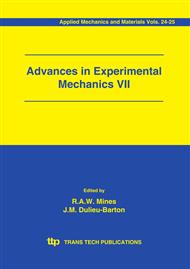[1]
J.A. Beltrán-Fernández & et. Al, Modelling of a Cervical Plate and Human Cervical Section C3 - C5 under Compression Loading Conditions Using the Finite Element Method, Transtech publications "Applied Mechanics and Materials, Vols. 13-14-2008 p. pp.49-56.
DOI: 10.4028/www.scientific.net/amm.13-14.49
Google Scholar
[2]
Huiskes R, Chao EYS. A survey of finite element analysis in orthopaedic biomechanics: the first decade. Journal of Biomechanics 16: 385-409, (1983).
DOI: 10.1016/0021-9290(83)90072-6
Google Scholar
[3]
Prendergast PJ. Finite element models in tissue mechanics and orthopaedic implant design. Clinical Biomechanics 12: 343-366, (1997).
DOI: 10.1016/s0268-0033(97)00018-1
Google Scholar
[4]
Holzpafel GA, Ogden RW, Eds. Mechanics of Biological Tissues. Springer, Berlin, (2006).
Google Scholar
[5]
Lally C, Kelly DJ, Prendergast PJ. Stents, In Wiley Encyclopedia of Biomedical Engineering, (Ed.: M. Akay), John Wiley & Sons, Vol. 5, pp.3345-3355, (2007).
DOI: 10.1002/9780471740360.ebs1142
Google Scholar
[6]
Van der Meulen MCH, Huiskes R. Why mechanobiology?, A survey article. Journal of Biomechanics 35: 401-414, (2002).
DOI: 10.1016/s0021-9290(01)00184-1
Google Scholar
[7]
Panjabi M M; Pelker R R; Friedlaender G E; Markham T C; Moen C J Effects of freezing and freeze-drying on the biomechanical properties of rat bone. Journal of orthopaedic research: official publication of the Orthopaedic Research Society 1984; 1(4): 405-11.
DOI: 10.1002/jor.1100010409
Google Scholar
[8]
Beltrán-Fernández JA & et. al., Mechanical Behavior of a Calcium Phosphate Ceramic Bone Graft used in the Rehabilitation of a C4 Human Vertebra", published by Transtech in "Applied Mechanics and Materials,. 5th BSSM International Conference on Advances in Experimental Mechanics, University of Manchester, UK, 4-6 September (2007).
DOI: 10.4028/www.scientific.net/amm.7-8.101
Google Scholar
[9]
J. A. Beltrán Fernández, L. H. Hernández Gómez, G. Urriolagoitia Calderón, M. Dufoo Olvera and A. González Rebatú, Distribución de esfuerzos por la acción de cargas de compresión en la vértebra cervical C5, empleando el Método del Elemento Finito, Científica, Vol. 9, núm. 3, Julio-Septiembre del 2005, ISSN 1665-0654, 135-142.
DOI: 10.4028/www.scientific.net/amm.13-14.49
Google Scholar
[10]
R. Rodríguez-Cañizo, L. Hernández-Gómez, J. Beltrán-Fernández, G. Urriolagoitia-Calderón, M. Dufoo-Olvera, Análisis biomecánico de un disco intervertebral porcino lesionado - estudio experimental, 8º CONGRESO IBEROAMERICANO DE INGENIERÍA MECÁNICA, (Cusco, Perú), 23 al 25 de Octubre, (2007).
DOI: 10.5944/bicim2022.020
Google Scholar
[11]
Zcorp, Self-Positioning Handheld 3D Scanner, Method Sheet: Scanning Multi-colored or Multi-shaded Part, Document: MS020016 (2007).
Google Scholar
[12]
J. A Beltrán-Fernández, Análisis numérico de las cervicales C3 - C7 asociado al problema del latigazo cervical, Tesis de Doctorado, Sección de Estudios de Posgrado e Investigación, ESIME Zacatenco, México. (2007).
Google Scholar
[13]
Ortosintese (2006), Catálogo de productos 2006, Rua Friedrich Von Voith, 896 - Jaragua, Brasil.
Google Scholar
[14]
Ruíz-Muñoz, E. R, Beltrán-Fernández, J. A & Et al, Técnicas de modelado en 3D aplicado a casos de vértebras porcinas por medio de un escáner 3D y tomografías., XXV Congreso Nacional De Investigación Biomédica, Universidad Autónoma de Nuevo León, Facultad de Medicina, (2009).
DOI: 10.30918/mri.64.18.022
Google Scholar
[15]
Allen, B., Ferguson, R., Et. al. (1982), A mechanistic classification of closed, indirect fractures and dislocations of the lower cervical spine, J. of Spine, vol. 7, p. pp.1-27.
DOI: 10.1097/00007632-198201000-00001
Google Scholar
[16]
J.A. Beltran-Fernández, L.H. Hernández-Gómez, G. Urriolagoitia-Sosa, A. González-Rebatú, G. Urriolagoitia-Calderón, (2009).
DOI: 10.4028/www.scientific.net/kem.478.103
Google Scholar
[17]
Ruíz-Muñoz, ER1, Beltrán-Fernández, JA, Rodríguez-Cañizo, RG, Hernández-Gómez LH, González-Rebatú A, (2009).
Google Scholar
[18]
Bland JH. Disorders of the cervical spine, diagnosis and medical management. 2nd ed. Philadelphia: WB Saunders; (1994).
Google Scholar
[19]
Information on http: /www. shutterstock. com/pic-31223248-x-ray-image-of-cervical- vertebra. html.
Google Scholar


